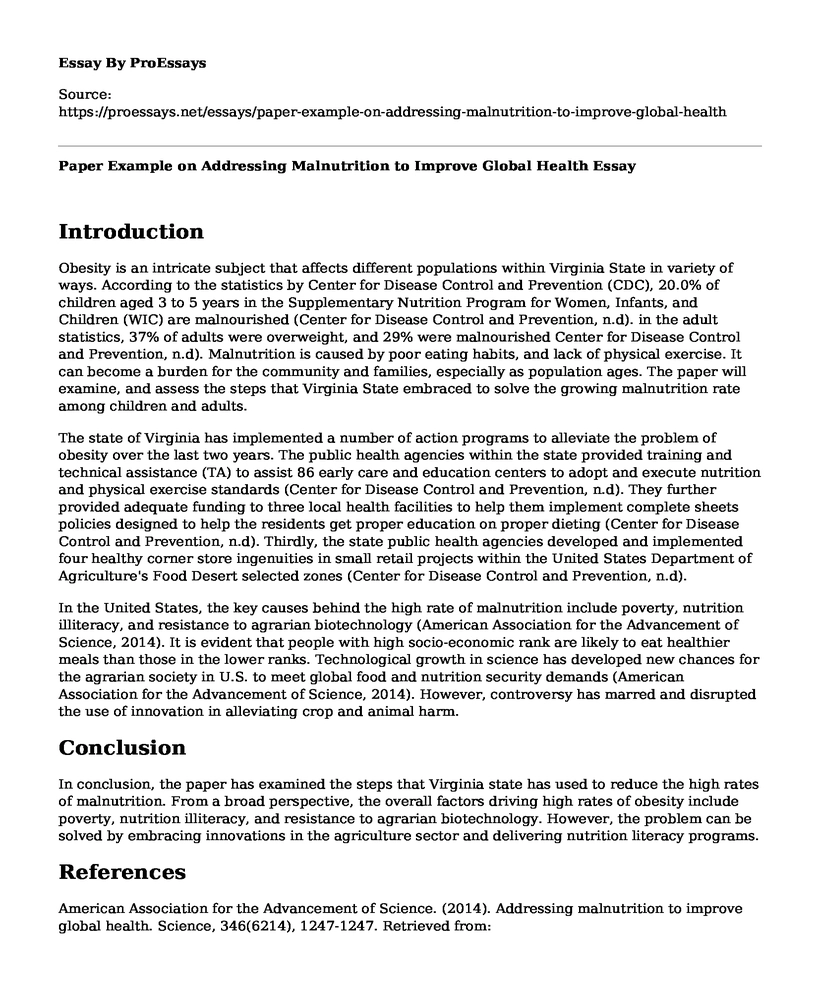Introduction
Obesity is an intricate subject that affects different populations within Virginia State in variety of ways. According to the statistics by Center for Disease Control and Prevention (CDC), 20.0% of children aged 3 to 5 years in the Supplementary Nutrition Program for Women, Infants, and Children (WIC) are malnourished (Center for Disease Control and Prevention, n.d). in the adult statistics, 37% of adults were overweight, and 29% were malnourished Center for Disease Control and Prevention, n.d). Malnutrition is caused by poor eating habits, and lack of physical exercise. It can become a burden for the community and families, especially as population ages. The paper will examine, and assess the steps that Virginia State embraced to solve the growing malnutrition rate among children and adults.
The state of Virginia has implemented a number of action programs to alleviate the problem of obesity over the last two years. The public health agencies within the state provided training and technical assistance (TA) to assist 86 early care and education centers to adopt and execute nutrition and physical exercise standards (Center for Disease Control and Prevention, n.d). They further provided adequate funding to three local health facilities to help them implement complete sheets policies designed to help the residents get proper education on proper dieting (Center for Disease Control and Prevention, n.d). Thirdly, the state public health agencies developed and implemented four healthy corner store ingenuities in small retail projects within the United States Department of Agriculture's Food Desert selected zones (Center for Disease Control and Prevention, n.d).
In the United States, the key causes behind the high rate of malnutrition include poverty, nutrition illiteracy, and resistance to agrarian biotechnology (American Association for the Advancement of Science, 2014). It is evident that people with high socio-economic rank are likely to eat healthier meals than those in the lower ranks. Technological growth in science has developed new chances for the agrarian society in U.S. to meet global food and nutrition security demands (American Association for the Advancement of Science, 2014). However, controversy has marred and disrupted the use of innovation in alleviating crop and animal harm.
Conclusion
In conclusion, the paper has examined the steps that Virginia state has used to reduce the high rates of malnutrition. From a broad perspective, the overall factors driving high rates of obesity include poverty, nutrition illiteracy, and resistance to agrarian biotechnology. However, the problem can be solved by embracing innovations in the agriculture sector and delivering nutrition literacy programs.
References
American Association for the Advancement of Science. (2014). Addressing malnutrition to improve global health. Science, 346(6214), 1247-1247. Retrieved from: https://www.sciencemag.org/site/products/collectionbooks/Abbott-booklet_v8_corrected_low_res_14apr15.pdf
Center for Disease Control and Prevention. Virginia State Nutrition, Physical Activity, and Obesity Profile. Retrieved from: https://www.cdc.gov/nccdphp/dnpao/state-local-programs/profiles/pdfs/virginia-state-profile.pdf
Cite this page
Paper Example on Addressing Malnutrition to Improve Global Health. (2022, Mar 23). Retrieved from https://proessays.net/essays/paper-example-on-addressing-malnutrition-to-improve-global-health
If you are the original author of this essay and no longer wish to have it published on the ProEssays website, please click below to request its removal:
- Essay Example: Extent to Which Obesity is Really a Health Problem
- Health: Benefits of Rope Skipping Essay Example
- Essay Sample on Material and Methods of Dentistry
- Essay Sample on the Effects of Bariatric Surgery in HIV Patients
- Article Analysis Essay on "Trauma and Intensive Care Nursing Knowledge"
- Essay Example on Neighborhood Fierceness Impacts Illness Control & Investigation
- Essay Sample on Achieving Healthy Sleep: Strategies from National Sleep Organizations







